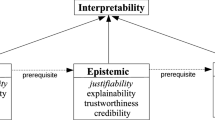Abstract
Interpretable machine learning focuses on learning models that are inherently understandable by humans. Even such interpretable models, however, must be trustworthy for domain experts to adopt them. This requires not only accurate predictions, but also reliable explanations that do not contradict a domain expert’s knowledge. When considering rule-based models, for example, rules may include certain variables either due to artefacts in the data, or due to the search heuristics used. When such rules are provided as explanations, this may lead to distrust.
We investigate whether human guidance could benefit interpretable machine learning when it comes to learning models that provide both accurate predictions and reliable explanations. The form of knowledge that we consider is that of preferred variables, i.e., variables that the domain expert deems important enough to be given higher priority than the other variables. We study this question for the task of multiclass classification, use probabilistic rule lists as interpretable models, and use the minimum description length (MDL) principle for model selection.
We propose S-Classy, an algorithm based on beam search that learns rule lists and takes preferred variables into account. We compare S-Classy to its baseline method, i.e., without using preferred variables, and empirically demonstrate that adding preferred variables does not harm predictive performance, while it does result in the preferred variables being used in rules higher up in the learned rule lists.
Access this chapter
Tax calculation will be finalised at checkout
Purchases are for personal use only
Similar content being viewed by others
Notes
- 1.
\(L_\mathbb {N}(i) = \log ^*i + \log {\lambda }, \text {where} \log ^*i = \log i + \log \log i+...\) and constant \(\lambda \approx 2.865064.\).
- 2.
The source code is available at: https://github.com/ioannapap/S-CLASSY.
- 3.
- 4.
\(Rank_{all}\) (smaller is better) is the average rank over all datasets.
- 5.
The lowest (\(>0\)) \(\mu |r|, \, \mu |R|\) the better, 0 is treated as the worst.
- 6.
For Jaccard distance, the closer to 0 the more similar and the closer to 1 the more different (preferred state).
References
Chaudhary, A., Kolhe, S., Kamal, R.: An improved random forest classifier for multi-class classification. Inf. Proc. Agric. 3(4), 215–222 (2016)
Clark, P., Boswell, R.: Rule induction with CN2: some recent improvements. In: Kodratoff, Y. (ed.) EWSL 1991. LNCS, vol. 482, pp. 151–163. Springer, Heidelberg (1991). https://doi.org/10.1007/BFb0017011
Cohen, W.W.: Fast effective rule induction. In: Machine Learning (1995)
Dzyuba, V., van Leeuwen, M.: Interactive discovery of interesting subgroup sets. In: Tucker, A., Höppner, F., Siebes, A., Swift, S. (eds.) IDA 2013. LNCS, vol. 8207, pp. 150–161. Springer, Heidelberg (2013). https://doi.org/10.1007/978-3-642-41398-8_14
Grünwald, P.D.: The Minimum Description Length Principle (Adaptive Computation and Machine Learning) (2007)
Hühn, J., Hüllermeier, E.: FURIA: an algorithm for unordered fuzzy rule induction. Data Min. Knowl. Disc. 19(3), 293–319 (2009). https://doi.org/10.1007/s10618-009-0131-8
Lakkaraju, H., Bach, S.H., Leskovec, J.: Interpretable decision sets: a joint framework for description and prediction. In: ACM SIGKDD, pp. 1675–1684 (2016)
Liu, B., Hsu, W., Ma, Y.: Integrating classification and association rule mining. In: ACM SIGKDD (1998)
Proenca, H.M.: Robust rules for prediction and description. Ph.D. thesis, Leiden University (2021)
Molnar, C.: Interpretable Machine Learning. Lulu.com, Morrisville (2020)
Proença, H.M., Grünwald, P., Bäck, T., van Leeuwen, M.: Robust subgroup discovery. Data Min. Knowl. Disc. 36(5), 1885–1970 (2022). https://doi.org/10.1007/s10618-022-00856-x
Proença, H.M., van Leeuwen, M.: Interpretable multiclass classification by MDL-based rule lists. Inf. Sci. 512, 1372–1393 (2020)
Quinlan, J.: C4.5: Programs for Machine Learning (2014)
Sarica, A., Cerasa, A., Quattrone, A.: Random forest algorithm for the classification of neuroimaging data in Alzheimer’s disease: a systematic review. Front. Aging Neurosci. 9, 329 (2017)
Schramowski, P., et al.: Making deep neural networks right for the right scientific reasons by interacting with their explanations. Nat. Mach. Intell. 2(8), 476–486 (2020)
Sokol, K., Flach, P.: Explainability is in the mind of the beholder: establishing the foundations of explainable artificial intelligence. ar**v preprint ar**v:2112.14466 (2021)
Von Rueden, L., et al.: Informed machine learning-a taxonomy and survey of integrating knowledge into learning systems. ar**v:1903.12394 (2019)
Yang, L., van Leeuwen, M.: Truly unordered probabilistic rule sets for multi-class classification. In: ECMLPKDD (2022)
Zhang, G., Gionis, A.: Diverse rule sets. In: ACM SIGKDD, pp. 1532–1541 (2020)
Acknowledgements
This work is supported by Project 4 of the Digital Twin research programme, a TTW Perspectief programme with project number P18-03 that is primarily financed by the Dutch Research Council (NWO).
Author information
Authors and Affiliations
Corresponding author
Editor information
Editors and Affiliations
Rights and permissions
Copyright information
© 2023 The Author(s), under exclusive license to Springer Nature Switzerland AG
About this paper
Cite this paper
Papagianni, I., van Leeuwen, M. (2023). Discovering Rule Lists with Preferred Variables. In: Crémilleux, B., Hess, S., Nijssen, S. (eds) Advances in Intelligent Data Analysis XXI. IDA 2023. Lecture Notes in Computer Science, vol 13876. Springer, Cham. https://doi.org/10.1007/978-3-031-30047-9_27
Download citation
DOI: https://doi.org/10.1007/978-3-031-30047-9_27
Published:
Publisher Name: Springer, Cham
Print ISBN: 978-3-031-30046-2
Online ISBN: 978-3-031-30047-9
eBook Packages: Computer ScienceComputer Science (R0)




